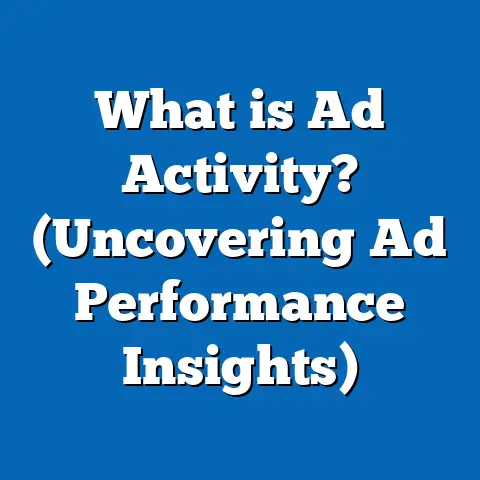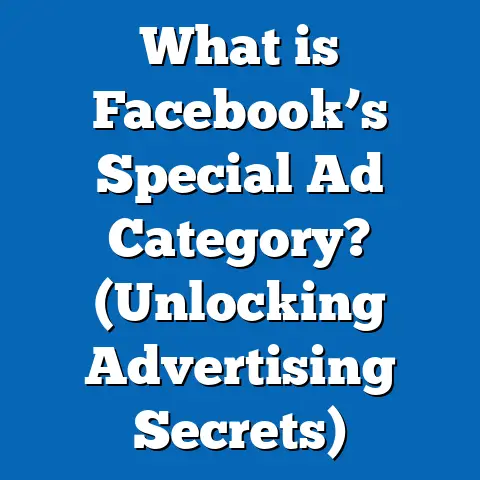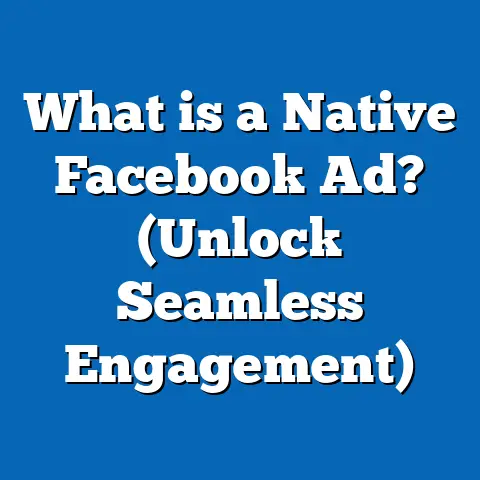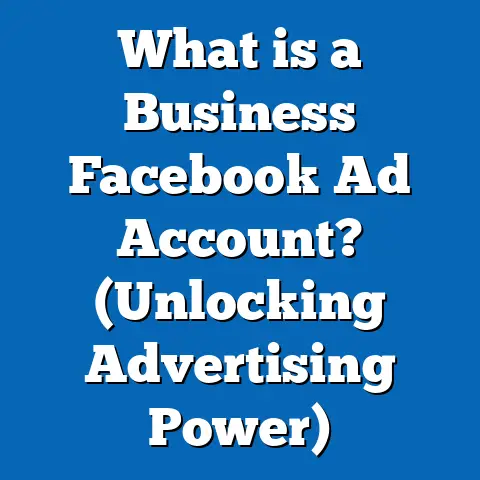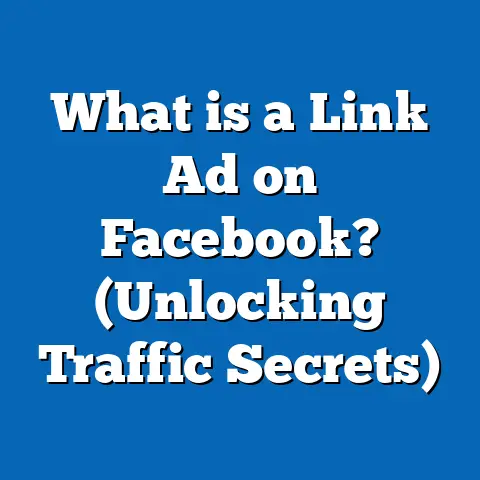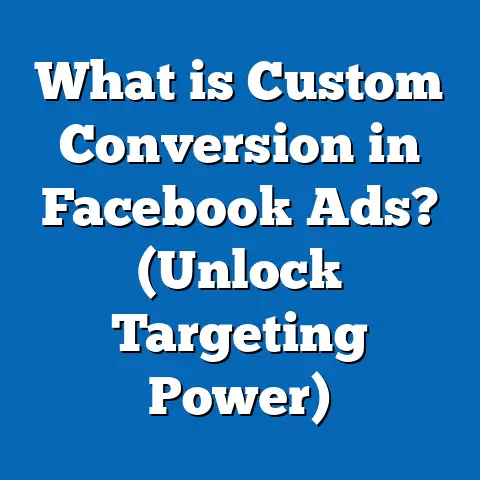What is a Facebook Conversion Ad? (Maximize Your ROI!)
What is a Facebook Conversion Ad? (Maximize Your ROI!)
Introduction: A Memory That Changed How We Advertise
Think back to a time when traditional marketing dominated—billboard ads, TV commercials, and cold calls. These methods relied heavily on reaching a broad audience and hoping for a small fraction to respond. Now, recall the last time you saw an ad on Facebook that seemed to know exactly what you wanted. Maybe it was a product you recently browsed or a service you needed. You clicked, signed up, or even made a purchase without hesitation. This was no accident; it was the power of Facebook Conversion Ads in action.
Facebook Conversion Ads have revolutionized the way businesses connect with potential customers by focusing not just on visibility but on driving tangible results. Understanding how these ads work and how to optimize them can transform your marketing efforts from guesswork into precision targeting that maximizes your return on investment (ROI). This article will guide you through everything from basic concepts to advanced techniques, practical examples, and data-backed insights to help you leverage Facebook Conversion Ads effectively.
Understanding Facebook Conversion Ads
What Are Facebook Conversion Ads?
Facebook Conversion Ads are specialized campaigns designed to encourage users to complete specific actions that are valuable to your business. These actions, known as conversions, may include:
- Making a purchase
- Signing up for a newsletter or webinar
- Filling out a contact form
- Downloading an app or content
- Adding items to a shopping cart
Unlike other types of ads focused primarily on clicks or impressions, conversion ads optimize delivery to users most likely to perform the desired action. This optimization is powered by Facebook’s advanced machine learning algorithms, which analyze user behavior and demographics to target the right audience at the right time.
Why Are Conversion Ads Important for Your Business?
Conversion Ads provide several key advantages that make them essential for modern marketing:
- Targeted Reach: They use behavioral data and user profiles to reach people with the highest likelihood of converting.
- Improved Cost Efficiency: Advertisers typically pay less per conversion compared to generic traffic or awareness campaigns.
- Clear ROI Measurement: The direct link between ad spend and specific business outcomes simplifies performance tracking.
- Enhanced Customer Insights: Tracking conversions offers valuable data about customer preferences and behaviors.
How Facebook Defines a “Conversion”
A “conversion” is any action that fulfills your campaign’s goal, measurable via Facebook tools like the Facebook Pixel. It’s important to define what conversions mean for your business clearly:
| Business Objective | Typical Conversion Event |
|---|---|
| E-commerce | Purchase |
| Lead generation | Form submission |
| Mobile app promotion | App install or in-app purchase |
| Content marketing | Newsletter signup or download |
| Event promotion | Ticket purchase or registration |
How Facebook Conversion Ads Work: The Technology Behind the Magic
The Role of Facebook Pixel
The Facebook Pixel is a piece of JavaScript code inserted into your website’s pages. It tracks user interactions and sends this data back to Facebook’s ad system. Actions tracked by the Pixel are called events, and these form the basis for conversion tracking.
Standard Events
Facebook offers predefined events that cover common actions:
- ViewContent: When a user views a product page.
- AddToCart: When a product is added to the shopping cart.
- InitiateCheckout: When checkout begins.
- Purchase: When the transaction completes.
- Lead: When a lead form is submitted.
Custom Events
If your business has unique conversion goals, you can set up custom events tailored specifically to those actions.
Data Flow: From Ad Click to Conversion Reporting
- A user sees or clicks your ad.
- The user visits your website where the Pixel tracks their behavior.
- The Pixel sends event data back to Facebook.
- Facebook’s algorithm uses this data for future ad delivery optimization.
- You monitor conversions through Facebook Ads Manager.
Optimization and Delivery
Facebook’s machine learning system optimizes ad delivery by showing your ads more frequently to users who are likely to convert based on historical data and modeling.
Detailed Breakdown of Facebook Conversion Ad Setup
Step 1: Installing the Facebook Pixel
- Go to Facebook Events Manager.
- Create your Pixel and copy the base code.
- Insert the Pixel code into your website header.
- Verify installation using Facebook Pixel Helper (a browser plugin).
Important: Pixel must be installed on all relevant pages, especially conversion pages (thank-you or confirmation pages).
Step 2: Defining Conversion Events
- Use standard event codes for common actions (e.g., Purchase).
- Customize events if needed for unique goals.
- Ensure events fire correctly via testing tools.
Step 3: Creating Your Conversion Campaign
- In Facebook Ads Manager, click “Create” and select “Conversions” as campaign objective.
- Choose the conversion event you want to optimize.
- Define your target audience using demographics, interests, behaviors, or custom audiences.
- Set your budget and schedule.
Step 4: Designing High-Converting Creatives
- Use strong visuals that highlight product benefits.
- Write clear headlines emphasizing value propositions.
- Include persuasive CTAs like “Shop Now,” “Sign Up,” or “Download.”
- Consider using video or carousel formats for richer storytelling.
Step 5: Launching and Monitoring
- Track campaign performance daily.
- Monitor key metrics: cost per conversion, return on ad spend (ROAS), conversion rate.
- Adjust targeting, budget, or creatives based on performance data.
Data Insights & Industry Statistics Supporting Facebook Conversion Ads
Performance Metrics That Matter
| Metric | Definition | Benchmark Range |
|---|---|---|
| Conversion Rate | Percentage of users completing desired action | 2% – 10% (varies by industry) |
| Cost Per Conversion (CPC) | Average spend per conversion | $10 – $50 (varies widely) |
| Return on Ad Spend (ROAS) | Revenue generated per dollar spent | 3x – 8x |
| Click-Through Rate (CTR) | Percentage of users clicking ad | 0.9% – 3% |
Industry Data
- According to WordStream, businesses using Conversion Ads achieve an average 30% higher ROI compared to traffic campaigns.
- Facebook reports advertisers see up to 20% lift in conversion rates after implementing Pixels correctly.
- Research by eMarketer shows that over 70% of digital marketers use conversion-focused campaigns for better accountability.
Case Studies: Real Businesses Winning with Facebook Conversion Ads
Case Study 1: Fashion E-commerce Boosts Sales by 50%
Background: A mid-sized apparel brand struggled with low online sales despite high website traffic.
Strategy:
- Installed Pixel and tracked “AddToCart” and “Purchase” events.
- Created Lookalike Audiences based on past buyers.
- Used carousel ads showcasing best-sellers.
Results After 4 Months:
- 50% increase in purchases.
- CPA reduced by 30%.
- ROAS increased from 2x to 5x.
Case Study 2: SaaS Company Doubles Trial Sign-ups
Background: A SaaS provider wanted more free trial sign-ups from their ads.
Strategy:
- Optimized campaigns for “Lead” event capturing sign-ups.
- Created custom audiences from website visitors.
- Tested video demos and testimonial ads.
Outcome:
- Trial sign-ups doubled in 3 months.
- Cost per lead dropped by 40%.
Advanced Techniques for Mastering Facebook Conversion Ads
Custom Conversions: Precision Beyond Standard Events
Custom conversions use URL rules or specific parameters to track detailed user behaviors that standard events can’t capture.
Example:
Tracking users who spend more than 5 minutes on pricing page before purchasing.
Lookalike Audiences: Expanding Reach Smartly
Lookalikes use data from your existing converters to find new users with similar characteristics.
Pro Tips:
- Start with 1% similarity for highest match quality.
- Create multiple lookalikes with different similarity thresholds for broader reach.
Dynamic Product Ads (DPA): Personalization at Scale
DPAs automatically retarget users with personalized ads featuring products they viewed but did not buy.
Benefits:
- Higher relevance increases conversion chances.
- Saves time creating individual ads for each product.
Retargeting Campaigns: Closing the Loop
Retarget users who interacted but didn’t convert with tailored messages reminding them to take action.
Example Workflow:
- Target users who added items to cart but abandoned checkout.
- Offer discounts or incentives in retargeting ads.
- Use countdown timers to create urgency.
Common Challenges & Solutions in Facebook Conversion Advertising
| Challenge | Cause | Solution |
|---|---|---|
| Low Conversions | Poor audience targeting or pixel setup | Expand audience; verify pixel; test creatives |
| High CPA | Inefficient bidding or ad fatigue | Use automatic bidding; rotate ads regularly |
| Attribution Delay | Users converting days after click | Adjust attribution window settings |
| Privacy Restrictions | iOS updates limit tracking | Use Aggregated Event Measurement; diversify channels |
Comparison With Other Platforms
| Aspect | Facebook Conversion Ads | Google Ads | LinkedIn Ads |
|---|---|---|---|
| Targeting | Behavioral + Demographics | Search keywords + intent | Professional + job-based |
| Cost | Lower CPC for B2C | Higher CPC but intent-driven | Higher CPM; niche professional |
| Best Use Case | B2C retail, app installs | Immediate need fulfillment | B2B lead generation |
| Tracking & Attribution | Pixel-based with broad reach | Google Analytics integration | Insight Tag tracking |
Facebook offers unparalleled social targeting and visual storytelling opportunities suited especially for B2C brands.
Practical Examples & Templates for Your Campaigns
Example Campaign Brief: E-commerce Product Launch
- Objective: Drive purchases of new headphones
- Pixel Event: Purchase
- Audience: Lookalike based on past buyers + Interest-based targeting (tech enthusiasts)
- Creative: Video showing product features + carousel of colors
- CTA: “Buy Now” with limited-time discount
- Budget: $50/day
- Metrics to Track: CPA, ROAS, CTR
Example Campaign Brief: Webinar Registration for SaaS Tool
- Objective: Maximize webinar sign-ups
- Pixel Event: Lead form submission
- Audience: Custom audience of website visitors + Lookalike of past registrants
- Creative: Testimonial video + image ad highlighting webinar benefits
- CTA: “Register Today”
- Budget: $30/day
- Metrics to Track: Cost per lead, registration rate
Best Practices for Successful Facebook Conversion Ads
- Install Pixel Correctly: Ensure every step in the funnel is tracked accurately.
- Start Small & Scale Slowly: Begin with a modest budget, then scale winners.
- Test Creatives Frequently: Rotate visuals and copy every 1–2 weeks.
- Use Clear CTAs: Tell users exactly what you want them to do.
- Leverage Retargeting: Remind interested users to complete their purchase or signup.
- Optimize for Mobile: Most Facebook traffic is mobile—ads must load fast and look good on all devices.
- Monitor Key Metrics: Focus on cost per conversion and ROAS over clicks or impressions.
Latest Trends Impacting Facebook Conversion Advertising
AI & Machine Learning Enhancements
Facebook’s AI continues improving ad delivery precision by analyzing vast datasets in real time, meaning better targeting and lower costs.
Privacy & Data Changes Post-iOS Updates
Apple’s App Tracking Transparency (ATT) requires user consent for tracking, limiting data available for optimization. Advertisers must:
- Use Aggregated Event Measurement (AEM)
- Rely more on first-party data from customers
- Diversify marketing channels beyond Facebook alone
Video Commerce Growth
Video ads with integrated shopping features are gaining traction, proving up to 30% higher conversion rates than static images according to recent surveys.
Deep Dive: Attribution Models Explained Simply
Attribution refers to how conversions get credited across multiple touchpoints in a customer journey.
Common Attribution Windows on Facebook
| Window Type | Description |
|---|---|
| 1-day click | Credit conversions within one day of click |
| 7-day click | Credit conversions within seven days of click |
| 1-day view | Credit conversions within one day of view |
| 7-day click + 1-day view | Default; credits based on both clicks & views |
Choosing the right window affects reported ROI and optimization strategies. Longer windows capture delayed conversions but may reduce precision.
FAQs About Facebook Conversion Ads
Q1: How long does it take for conversion ads to perform well?
A1: Typically, it takes about one week for the algorithm to learn and optimize effectively; performance usually improves over time with sufficient conversions.
Q2: Can I run conversion ads without a website?
A2: Yes, conversion events can also be tracked in apps via SDKs or using lead forms directly on Facebook/Instagram.
Q3: How much should I budget?
A3: Start small ($5-$20/day) during testing; scale once you find winning ads with profitable cost per conversion.
Q4: What if my pixel doesn’t track all conversions?
A4: Use manual tracking methods like UTM tags combined with Google Analytics for cross-verification.
Conclusion & Action Plan
Facebook Conversion Ads are among the most powerful tools available today for turning advertising dollars into measurable business results. By understanding how they work, installing proper tracking, targeting smartly, creating compelling creatives, and continuously optimizing campaigns based on data, marketers can significantly improve ROI.
Summary:
- Conversion Ads focus on driving valuable actions beyond clicks or impressions.
- Proper setup with Facebook Pixel is essential for accurate tracking and optimization.
- Use Lookalike Audiences, custom conversions, dynamic ads, and retargeting for maximum impact.
- Monitor key metrics closely and adapt based on performance data.
- Stay abreast of privacy changes and platform updates affecting targeting and attribution.
Your Next Steps:
- Install the Facebook Pixel across your website if not already done.
- Define clear conversion goals aligned with your business objectives.
- Launch small-scale conversion campaigns focusing on one key event at a time.
- Use Lookalike Audiences built from high-value customers.
- Test multiple creative formats including videos and carousels.
- Monitor daily and optimize budget allocation toward top-performing ads.
- Plan retargeting campaigns to re-engage interested users.
- Keep updated on privacy regulations and adjust accordingly.
Mastering Facebook Conversion Ads is an ongoing process but one well worth investing time and resources into—your business growth depends on it!
If you’d like help creating tailored campaign setups or troubleshooting existing ones, just ask!

